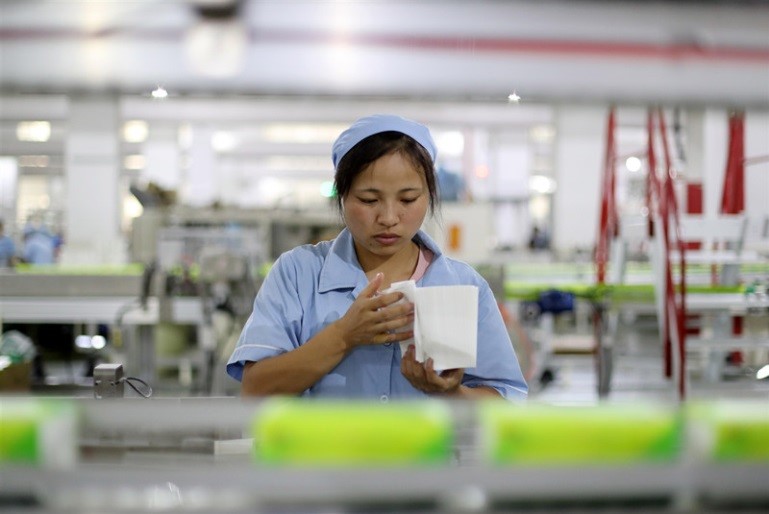(Global Times)10:38, August 08, 2019![]()

On July 22, 2019, Hengan (Jiangxi) Household Products Co., Ltd., located in the Economic Development Zone of Dongxiang District, Fuzhou City, Jiangxi Province, was in a busy scene in the third phase of the factory, and workers were busy producing. (Photo by He Jianghua from People鈥檚 Daily Online)
The investment in fixed assets in China grew at an average annual rate of 15.6 percent over the past 70 years, according to the National Bureau of Statistics (NBS) on July 30, in a report regarding achievements in economic and social development since the People鈥檚 Republic of China was founded.
Analysts say that fixed investment is the basis for development and the high growth rate shows China鈥檚 sound foundation and huge potential for economic growth and sustainability, as the figure provides important clues as to the economy鈥檚 capacity to produce more goods and services.
China鈥檚 investment in infrastructure and basic industries has kept growing over the past years. Investment in the transportation industry grew at an average annual rate of 16.7 percent from 1996 to 2018, according to the report.
鈥淐hina鈥檚 infrastructure grew out of nothing from 70 years ago, and now leads the world in infrastructure investment, with the nickname 鈥榠nfrastructure maniac,鈥欌€?Zhao Xijun, vice director of the School of Finance at Renmin University told the Global Times on July 30.
China has formed a comprehensive transportation network including railways, roads, water transport and air transport. In terms of information transmission, the total length of optical cable lines in China ranked first in the world by the end of 2018, which shows the outstanding effect of investment in the information industry, according to the report.
鈥淐hina is the world champion in terms of the length of railways and roads, as well as the number of big bridges and ports,鈥?said Zhao.
Over the past 70 years, investment has been one of the major drivers of China鈥檚 economic development, with the national capital formation rate (the proportion of total capital formation in GDP during an accounting period for a country) rising from 38.9 percent in 1978 to 48.5 percent in 2011, the highest since the reform and opening-up, the report said.
The capital formation rate was 48.2 percent in 2010 when China became the second largest economy in the world and outpaced Japan, whose rate was 19.8 percent, according to data from the World Bank.
In 2018, China鈥檚 capital formation rate stood at 44.9 percent, and total capital formation contributed 32.4 percent to economic growth, said NBS.
With the continuous growth of its economic power, China鈥檚 industrial structure has begun to move toward high-end industries, and investment in high-tech industries has been growing rapidly.
From 2013 to 2018, China鈥檚 investment in high-tech industries grew at an annual rate of 16.9 percent, 6.2 percentage points higher than was seen in the whole industry. Investment in high-tech manufacturing grew at an average annual rate of 15 percent, 5.4 percentage points higher than that of all manufacturing industries. Investment in high-tech services increased by 20.3 percent on average, 8.2 percentage points higher than the total investment in the service sector.
鈥淐hina has gained lots of experience from infrastructure construction as well as training talents, which makes a solid foundation for industry upgrade,鈥?said Zhao.
Some high-tech industries, including aerospace, satellite navigation, smartphones, computers and electronic communications, have formed an integrated, well-equipped and capable industrial ecosystem, moving toward the middle and high-end of the global industrial chain, the report said.
Meanwhile, the diversification pattern of Chinese investors has taken shape, increasing the vitality and driving force of reproduction. Particularly after the reform and opening-up, with the continuous improvement of the socialist market economy system, the enthusiasm for investment of various market entities has been stimulated.
According to the report, investment in state-owned and collective economies accounted for 28.6 percent in 2018, and investment in the share-holding sector accounted for 30.1 percent. The private sector made up 34.6 percent, and investment from foreign investors accounted for 4.5 percent.
From 2003 to 2018, non-public sector was gaining rising investment, and China鈥檚 private investment grew at an average annual rate of 22.4 percent and accounted for 62.6 percent of total investment in 2018, up from 38.1 percent in 2003.
According to the NBS, China contributed more than 20 percent of the world鈥檚 economic growth annually from 2008 to 2012. In the past five years, China has contributed more than 30 percent to world economic growth, making it the number one engine of global growth.
